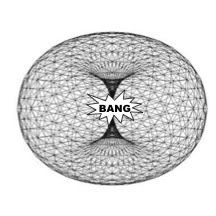Is the Universe a Holographic Reality? - Global One TV |
|
Results 1 to 25 of 34
Thread: The Holographic universe
Hybrid View
-
07-16-2011 10:16 PM #1
Last edited by IndieAnthias; 07-16-2011 at 10:21 PM.

-
07-17-2011 04:17 AM #2widdershins modality Achievements:









- Join Date
- Jul 2004
- Gender

- Location
- Ohiopolis
- Posts
- 4,843
- Likes
- 1004
- DJ Entries
- 19
I suspect the OP is talking about the "holographic universe" put forward by Michael Talbot based on his interpretation of Bohm and Pribram (I'm mainly familiar with it from Itzhak Bentov's Stalking the Wild Pendulum, recommended for anyone with an interest in the subject), and popularized in the '70s Transcendental Meditation movement. It's really an extended metaphor borrowing language and imagery from science, a (useful, I think) way of thinking about time and space, not a description of physical properties of time and space. It probably should have been placed in the main ED forum and the OP probably should have been more specific.
I'd say go ahead and explore it if it resonates with you, but don't get too hung up on it.
You might enjoy Orson Scott Card's novel Pastwatch (easily his best work, IMO).
My own take on this notion of drawing specific, historical information out of the a-temporal (aka eternal) 'level' or 'side' of our existence is that it's an attempt to get a dissected frog to catch flies. To consider the holographic universe in any depth, one must set aside the notion that happening (undergoing the formality of actually occurring in our linear experience of the universe) has some privileged status. The unchanging, a-temporal totality of being includes not only all happenings, but all possibilities. The appearance of specific events taking place in an ordered chain of causality is strictly a manifestation of consciousness. So, even if we could mine eternity for detailed information, even first-hand vision of a past, it wouldn't necessarily be our past (what most of us ordinarily consider the past).
Bentov represents holographic time graphically as a torus (donut, for the geometrically challenged) centered on a singularity:

The events of our history (and future) trace a single line emerging up and out from the singularity, falling back, and eventually returning into the singularity. The whole torus is always there, and in some sense the totality is accessible from any point or area of the surface, but the illusion of the present, of separate forms and unfolding events, is just the reflection from one small facet of the always present, unchanging totality.
Yeah, not exactly Sci/Math material Still, I wouldn't say it's quite Inner Sanctum fodder, either, until you bring in the stuff about achieving a resonant frequency with the interference pattern of the universe through Transcendental Meditation
Still, I wouldn't say it's quite Inner Sanctum fodder, either, until you bring in the stuff about achieving a resonant frequency with the interference pattern of the universe through Transcendental Meditation  If you have a sense of caring for others, you will manifest a kind of inner strength in spite of your own difficulties and problems. With this strength, your own problems will seem less significant and bothersome to you. By going beyond your own problems and taking care of others, you gain inner strength, self-confidence, courage, and a greater sense of calm.Dalai Lama
If you have a sense of caring for others, you will manifest a kind of inner strength in spite of your own difficulties and problems. With this strength, your own problems will seem less significant and bothersome to you. By going beyond your own problems and taking care of others, you gain inner strength, self-confidence, courage, and a greater sense of calm.Dalai Lama
-
07-19-2011 11:19 PM #3
This stuff is pure gold. Of course it's forced on us by even special relativity (specifically, the relativity of simultaneity) and strongly hinted at by the many worlds interpretation of quantum mechanics.
This "big bang" isn't a "was but an "is" that is happening right "now".Previously PhilosopherStoned
Similar Threads
-
holographic universe.
By utazian in forum ResearchReplies: 1Last Post: 02-20-2011, 11:38 PM -
The Holographic Universe - Beyond Matter
By Sahaja in forum PhilosophyReplies: 47Last Post: 10-19-2007, 08:19 AM -
The holographic universe
By cygnus in forum PhilosophyReplies: 5Last Post: 09-25-2007, 04:58 AM -
Holographic Theory
By YourTheManNowDog in forum PhilosophyReplies: 4Last Post: 10-24-2005, 04:32 AM




 11Likes
11Likes LinkBack URL
LinkBack URL About LinkBacks
About LinkBacks





 Reply With Quote
Reply With Quote


Bookmarks